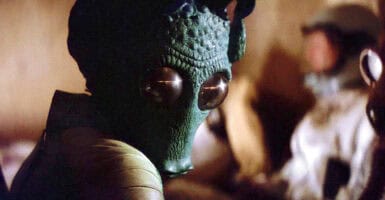Voyager 1 Carries Our Legacy Into The Universe In Gorgeous CGI Short Stardust
This article is more than 2 years old
“It has been said that astronomy is a humbling and character-building experience. There is perhaps no better demonstration of the folly of human conceits than this distant image of our tiny world.” Carl Sagan wrote those words in his book Pale Blue Dot: A Vision of the Human Future in Space. It referred to the photograph that lent the book its name, a shot of Earth taken by Voyager 1. From a distance of some 3.7 billion miles, Earth looked like little more than “a mote of dust suspended in a sunbeam.” It’s one of those images that hammers home the sheer, awe-inspiring size of our cosmos, as well as our own fleeting existence when compared to the billions of years that stretch out behind and before us. The gorgeous short film Stardust, seen above, imagines our legacy carrying on, even if we do not, with Voyager 1 continuing its journey — and carrying the memory of us — long after our sun has died.
Stardust was created by PostPanic writer/director Mischa Rozema, in response to the 2011 death of Dutch graphic designer Arjan Groot, who passed away at the young age of 39. It’s a beautiful meditation on the momentary flicker that is our lives, but also the happier thought that something of us will survive. The stunning CGI work, and the accompanying music by Guy Amitai, imagines the eventual death of our sun, and with it our homeworld, contrasted against Voyager 1, still out there, still traveling, perhaps some day to be found by others, who might learn something of our story.
All of us struggle with the notions of mortality, so it’s genuinely comforting to think of something our species created outliving us, or at least the world where it was created. Even though it unfolds without any dialogue, it reminds me quite a bit of Sagan’s “Pale Blue Dot” that I mentioned above, a reminder that Earth is the only home we’ve got, but that unless we take our species out into the galaxy, there can be only one inevitable end for us, even if we survive the billions of years that remain before our sun decides it’s time to close up shop.
Here’s what Rozema has to say about Stardust on the film’s Vimeo page:
From a creative standpoint, Rozema wanted to explore our preconceived perceptions of how the universe appears which are fed to us by existing imagery from sources such NASA or even sci-fi films. By creating a generated universe, Rozema was able to take his own ‘camera’ to other angles and places within the cosmos. Objects and experiences we are visually familiar with are looked at from a different point of view. For example, standing on the surface of the sun looking upwards or witnessing the death and birth of a star — not at all scientifically correct but instead a purely artistic interpretation of such events.
Rozema says, ‘I wanted to show the universe as a beautiful but also destructive place. It’s somewhere we all have to find our place within. As a director, making Stardust was a very personal experience but it’s not intended to be a personal film and I would want people to attach their own meanings to the film so that they can also find comfort based on their own histories and lives.’












